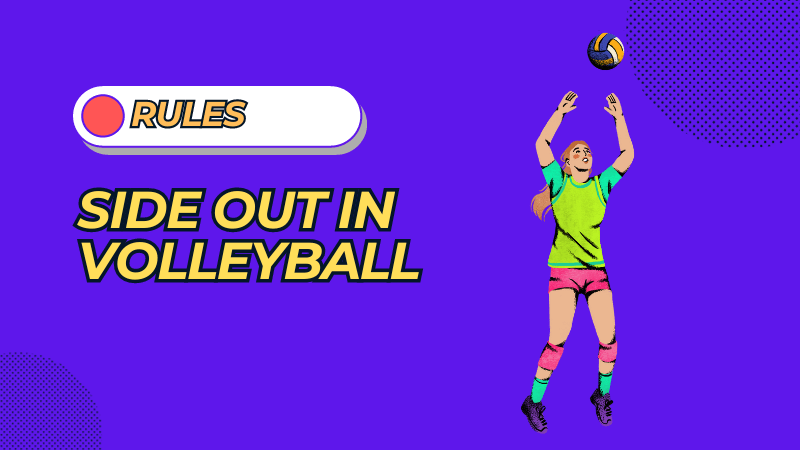Volleyball enthusiasts and players often hear the term “sideout,” but what does it truly mean in volleyball? The complexity and evolution of this term can create confusion for newcomers and even seasoned players. It is a concept that goes beyond merely scoring a point or winning a rally.
The term “side out” originated from the original scoring system of volleyball, where only the serving team could score points. If the receiving team won the rally, they would gain the right to serve, but not a point. Over time, the meaning has changed, but the significance remains.
Understanding the concept of a side out is essential for grasping the intricacies of volleyball. It plays a key role in offensive and defensive strategies and has become a vital part of modern-day volleyball. Whether you’re a player, a coach, or a fan, the sideout is a fascinating game aspect worth exploring.
What Is the Definition of Side Out in Volleyball?
A side out in volleyball is the termination of a team’s right to serve, which occurs when the serving team fails to score a point, and the receiving team gains the right to serve. This concept has a rich history in the game, and while its meaning has evolved, its impact on the game remains significant.
In the original scoring system, a side out meant that the team that served had to move to the other side of the court, hence the term. They lost the right to serve, and the opposing team would gain this right without earning a point.
Over time, the meaning of a sideout has changed, particularly with the shift from the side-out scoring system to the rally scoring system in 1999. Now, a side out simply means that the receiving team wins the rally and win a point, even though it no longer requires moving to the other side of the court.
Understanding side-outs is crucial for volleyball players, coaches, and fans alike, as it represents a strategic element in the game, influencing momentum and tactics. Whether you’re playing beach volleyball or a professional tournament, the side out is a foundational component of volleyball that shapes how the game is played and enjoyed.
What Happens When a Sideout Is Called In Volleyball?

When a side out is called in volleyball, it signifies a shift in the game’s momentum. The receiving team gains the right to serve, and the serving team rotates one position clockwise. This rotation allows a different player to serve, adding variety and potentially new strategies to the game.
The moment a side-out is called, it’s a cue for both teams to recalibrate. The serving team must adapt to the lost opportunity to score, while the receiving team sees a chance to take control of the game and impose their tactics.
In professional volleyball, achieving a side out often demands precise coordination and execution. Each move counts towards this objective, from a tactical serve to an effective block.
While “side out” refers to an old volleyball scoring system, its modern interpretation still represents a significant turning point within a match1. Coaches, players, and fans recognize the importance of sideouts in shaping the game’s flow, making it an essential concept for anyone involved in volleyball.
Also, Read: Why Do Volleyball Players Tape Their Fingers?
The Benefits of Siding Out Your Opponent
Transitioning from the mechanics of a side out, it’s essential to delve into why this play is crucial in the game of volleyball. Siding out your opponent can provide a psychological and tactical edge, influencing the momentum and dynamics of the match. It’s more than just a rule; it’s a strategic tool that can lead to victory.
How Many Points Is a Side Out in Volleyball?
A common misconception in volleyball is that a side out directly translates into points for the team that achieves it. In reality, a side-out does not earn any points. Rather, it represents the termination of the serving team’s right to serve and allows the receiving team to gain the right to serve the ball.
This volleyball rule adds a layer of complexity to the game, requiring teams to think beyond merely scoring points. Achieving a side out can influence the game’s flow, create scoring opportunities, and even pressure the opposing team.
It’s a vital part of the game’s strategy, bridging the gap between defense and offense, and requires keen understanding and execution.
Different Strategies for Side Out Scoring in Volleyball
Achieving a side out is a central goal for a volleyball team, particularly when playing defensively. Since it represents the termination of the serving team’s right to serve and a chance for the receiving team to seize control, different strategies can be employed to earn a side out. These strategies often involve a combination of skill, timing, and teamwork.
- Serving Aggressively: An aggressive serve can put the opposing team on the back foot, disrupting their formation and creating opportunities to win the rally.
- Targeting Weaker Passers: Identifying and targeting weaker passers on the opposing team can lead to mistakes and give the receiving team a better chance to win the rally.
- Using Deceptive Serves: Mixing up serves with different speeds, spins, and trajectories can confuse the opposing team and lead to a successful side out.
These tactics require practice, coordination, and a deep understanding of the game’s dynamics. Coaches often analyze opponents to find the best approach for earning slideouts, recognizing the significance of this element in winning matches.
Whether it is through power, precision, or psychology, earning a side out is a multifaceted challenge. It demands players to be adaptive, creative, and cohesive as a team, making it one of the thrilling aspects of the game that fans and players enjoy. It’s not just about winning a single rally; it’s about setting the stage for a winning performance.
Side Out vs. Rally Scoring System: Understanding the Difference of Rules in Volleyball

In the ever-evolving game of volleyball, the way points are scored has significantly changed. Two primary scoring methods have shaped the sport: Side Out and Rally scoring. Understanding these differences adds depth to a fan’s appreciation of the game and plays a crucial role in how teams approach and strategize during a match.
Side Out Scoring
In Side Out scoring, only the serving team can score a point. If the receiving team wins the rally, that team earns the right to serve, but not a point, a situation referred to as a “side out.” This method used to be the standard in volleyball, making the game more challenging and prolonged since the serving team could only score a point.
Rally Scoring
Contrastingly, Rally Scoring, adopted by the FIVB in 1999, revolutionized the game by awarding a point on every rally, regardless of which team serves. This system was intended to make the game more exciting, unpredictable, and faster-paced.
These two scoring systems present unique dynamics and require different strategies. While Side Out scoring emphasizes the importance of maintaining the serve, Rally Scoring focuses on every single rally, making each one a potential point-scoring opportunity.
Interestingly, some leagues and tournaments still use a hybrid version of these systems, such as the NCAA women’s volleyball, which uses a 25-point Rally scoring system for the first four sets but switches to a 15-point Side Out scoring system for the decisive set.
The shift from Side Out to Rally Scoring marked a pivotal moment in the sport’s history, reflecting the modernizing trends and the desire to make the game more engaging for players and spectators. It’s a fascinating aspect of volleyball that continues to influence how the game is played and enjoyed worldwide.
Also, Read: Can You Block a Serve in Volleyball?
Evolution of Volleyball Scoring: The Shift Away From Sideouts

As someone who’s been deeply involved in volleyball, I’ve witnessed the transformative changes in scoring systems. One of the most remarkable evolutions in the sport has been the shift away from the traditional side-out scoring system.
The Sideout Era
In the old volleyball days, the Sideout scoring system was the norm, where only the serving team could score a point. If the receiving team won the rally, they would gain the right to serve but not a point, leading to a “side out.” This system created intense, prolonged matches, where trading serves instead of scoring points was common.
The Introduction of Rally Scoring
The turn of the century marked a significant shift in the game’s dynamics. In 1999, the FIVB (Fédération Internationale de Volleyball) adopted the Rally Scoring system, where every rally results in a point for either team2. This move aimed to make matches more exciting and unpredictable, as well as shorten their duration.
The Hybrid System
Interestingly, the transition was not an absolute abandonment of the Sideout system. Some leagues and tournaments, like NCAA women’s volleyball, embraced a hybrid version. They incorporated a 25-point Rally scoring system for the first four sets and a 15-point Sideout scoring system for the decisive fifth set.
Modern-Day Volleyball
Today, the term “side out” still echoes in modern-day volleyball but has a different meaning. It refers to an occurrence where the receiving team wins the rally and earns a point, regardless of whether it gains the serve or not. The shift from Side Out scoring to Rally Scoring was more than just a rule change; it symbolized volleyball’s evolution into a more engaging and dynamic sport.
This evolution has added layers of complexity and strategy to the game and made it more appealing to spectators. The shift away from Sideouts is a testament to how professional volleyball has evolved and adapted to the modern era, continually seeking ways to elevate the game’s excitement and competitive spirit.
Also, Read: Ultimate Guide to Spike a Volleyball Like a Pro
Wrapping Up
The shift from Sideout scoring to Rally Scoring in volleyball marks a significant evolution in the sport. This transformation changed not only the waypoints were scored but also the very dynamics of the game itself.
From the traditional Sideout system, where only the serving team could score, to the introduction of Rally Scoring that made every rally crucial, the change injected excitement and unpredictability into matches. Some leagues even embraced a hybrid approach, combining both scoring systems.
The term “side out” remains in volleyball players’ vocabulary but has a different meaning, reflecting the sport’s growth and adaptation. It’s a testament to the game’s continual evolution, ensuring that volleyball remains engaging, competitive, and ever-appealing to players and fans alike.
FAQS:
Why Do People Yell Sideout in Volleyball?
People yell “sideout” in volleyball as a rallying cry. The term has its roots in the game’s history, where a sideout meant regaining the serve without scoring a point. Today, it’s a vocal encouragement for the team to win the rally, regain serve, and perhaps even score a point, emphasizing the importance of each play.
How Many Points Is a Side Out in Volleyball?
In modern volleyball, a sideout itself does not earn any points. It refers to the receiving team winning the rally, thereby gaining the right to serve. With the adoption of rally scoring, either team can score points during a rally, unlike the old sideout scoring system where only the serving team can score.
What Are Some Effective Strategies to Earn a Sideout?
Earning a sideout in volleyball requires both offensive and defensive prowess. Strategies include serving aggressively to disrupt the receiving team, targeting weaker passers, and using deceptive serves. On defense, coordinated blocking, positioning, and effective communication among players can contribute to winning a sideout.
How Do Sideouts Affect Momentum in a Volleyball Game?
Sideouts play a critical role in shifting momentum within a volleyball match. By winning a sideout, a team can break the opponent’s serve and gain control of the game. This can lead to a psychological advantage, as it pressures the opposing team to respond. Consistent success in siding out your opponent helps to build confidence and can swing the momentum in your team’s favor, potentially leading to victory in the game.

